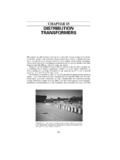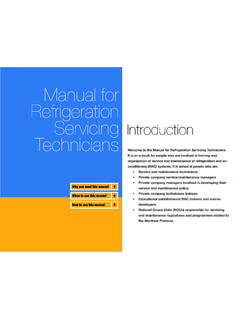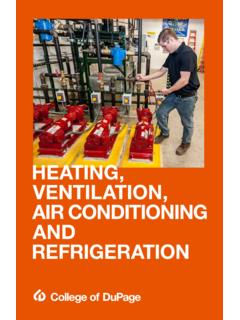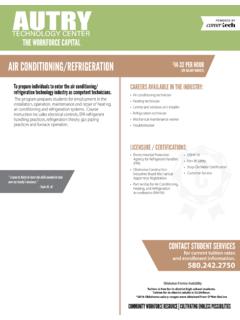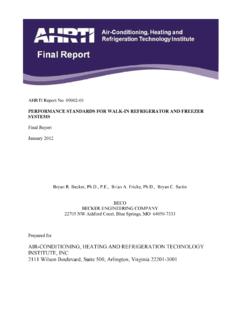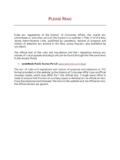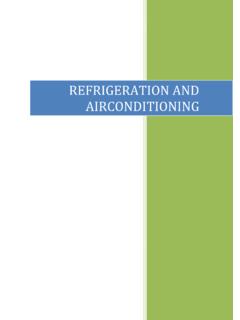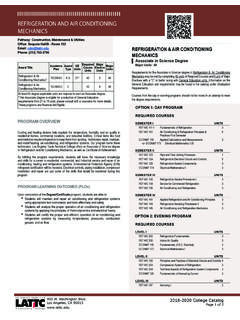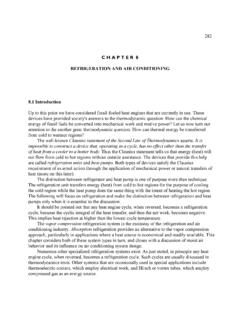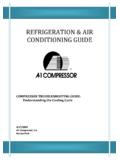Transcription of Air Conditioning and Refrigeration - …
1 Air 2/28/06 1:58 PM Page 2/28/06 1:58 PM Page iiAir ConditioningandRefrigerationREXMILLERP rofessor EmeritusState University College at BuffaloBuffalo, New YorkMARKR. MILLERP rofessor, Industrial TechnologyThe University of Texas at TylerTyler, TexasMcGraw-HillNew York Chicago San Francisco Lisbon LondonMadrid Mexico City Milan New Delhi San JuanSeoul Singapore Sydney 2/28/06 1:58 PM Page iiiLibrary of Congress Cataloging-in-Publication DataMiller, Rex, Conditioning and Refrigeration / Rex Miller, Mark R. 0-07-146788-21. Air Conditioning . 2. Refrigeration and refrigerating machinery. I. Miller, Mark 6 dc222005058099 Copyright 2006 by The McGraw-Hill Companies, Inc. All rights reserved. Printed inthe United States of America.
2 Except as permitted under the United States Copyright Actof 1976, no part of this publication may be reproduced or distributed in any form or byany means, or stored in a data base or retrieval system, without the prior written permis-sion of the publisher. 1234567890 QPD/QPD012109876 ISBN 0-07-146788-2 The sponsoring editor for this book was Larry S. Hager and the production supervisorwas Pamela A. Pelton. It was set in Times by International Typesetting andComposition. The art director for the cover was Handel and bound by books are available at special quantity discounts to use as premiums and salespromotions, or for use in corporate training programs. For more information, please write tothe Director of Special Sales, McGraw-Hill Professional, Two Penn Plaza, New York, NY10121-2298.
3 Or contact your local book is printed on acid-free contained in this work has been obtained by TheMcGraw-Hill Companies, Inc. ( McGraw-Hill ) from sourcesbelieved to be reliable. However, neither McGraw-Hill nor itsauthors guarantee the accuracy or completeness of any informationpublished herein, and neither McGraw-Hill nor its authors shall beresponsible for any errors, omissions, or damages arising out ofuse of this information. This work is published with the under-standing that McGraw-Hill and its authors are supplying infor-mation but are not attempting to render engineering or otherprofessional services. If such services are required, the assistanceof an appropriate professional should be 2/28/06 1:58 PM Page ivVoltmeter 25 Ohmmeter 26 Multimeter 26 Wattmeter 27 Other instruments 28 Air Filter Efficiency Gages 28 Air-Measurement Instruments 28 Humidity-Measurement Instruments 29 Vibration and Sound Meters 29 Service Tools 30 Special Tools 31 Vacuum Pumps 32 Vacuum Pump Maintenance 34 Vacuum Pump Oil Problems 34 Operating Instructions 34 Evacuating a System 35 Charging Cylinder 35 Charging Oil 36 Changing Oil 37 Mobile Charging Stations 37 Tubing 37 Soft Copper Tubing 37 Hard-Drawn Copper Tubing 38 Cutting Copper Tubing 39 Flaring Copper Tubing 40 Constricting Tubing 41 Swaging Copper Tubing 41 Forming Refrigerant Tubing 42 Fitting Copper Tubing by Compression 43 Soldering 43 Soft Soldering 44 Silver Soldering or Brazing 46 Testing for leaks 47
4 Cleaning and Degreasing Solvents 47 Review Questions 472 Development of RefrigerationPerformance Objectives 50 Historical Development 50 ContentsPreface xvAcknowledgments xvii1 Air- Conditioning andRefrigeration Toolsand InstrumentsPerformance Objectives 2 Tools and Equipment 2 Pliers and Clippers 2 Fuse Puller 2 Screwdrivers 2 Wrenches 3 Soldering Equipment 3 Drilling Equipment 4 Knives and Other Insulation-Stripping Tools 5 Meters and Test Prods 6 Tool Kits 7 Gages and Instruments 9 Pressure Gages 9 Gage Selection 10 Line Pressure 11 Effects of Temperature on Gage Performance 12 Care of Gages 12 Gage Recalibration 12 Thermometers 13 Pocket Thermometer 13 Bimetallic Thermometers 15 Thermocouple Thermometers 16 Resistance Thermometers 16 Superheat Thermometer 17 Superheat Measurement Instruments 17 Halide Leak Detectors 21 Setting Up 21 Lighting 22 Leak Testing the Setup 22 Adjusting the Flame 22 Detecting Leaks 22 Maintenance 22 Electrical Instruments 23 Ammeter 2/28/06 1.
5 58 PM Page vStructure of Matter 50 Elements 51 Atom 51 Properties of Matter 51 Pressure 52 Pressure Indicating Devices 52 Pressure of Liquids and Gases 53 Atmospheric Pressure 53 Gage Pressure 53 Absolute Pressure 53 Compression Ratio 54 Temperature and Heat 54 Specific Heat 55 Heat Content 55 Sensible Heat 55 Latent Heat 55 Other Sources of Heat 56 Refrigeration Systems 56 Refrigeration from Vaporization(Open System) 56 Basic Refrigeration Cycle 56 Capacity 57 Refrigerants 57 Refrigerant Replacements and the Atmosphere 58 Review Questions 593 Voltage, Current, andResistancePerformance Objectives 62 Ohm s Law 62 Series Circuits 62 Parallel Circuits 64 Current in a Parallel Circuit 64 Resistance in a Parallel Circuit 65AC and DC Power 65 Phase 66 Power in DC Circuits 66 Power Rating of Equipment 67 Capacitors 67 How a Capacitor Works 68 Capacity of a Capacitor 69 Dielectric Failure 69 Basic Units of Capacitance 69 Working with Capacitive Values 69 Capacitor Types 70 Capacitor Tolerances 73 The AC Circuit and the Capacitor 73 Uses of Capacitors 75 Inductance 75 Four Methods of Changing Inductance 75 Self-Inductance 75 Mutual Inductance 76 Inductive Reactance 77 Uses of Inductive Reactances 77 Transformers 77 Transformer Construction 77 Turns Ratio 78 Transformer Applications 78 Semiconductors 78 Diodes 78
6 Transistors 79 Silicon-controlled Rectifier (SCR) 80 Bridge circuits 80 Wheatstone Bridges 80 Variable Resistor 81 Sensors 81 Temperature Elements 82 Humidity Elements 82 Controllers 83 Single-Element Controllers 84 Dual-Element Controllers 86 Actuators 86 Electro-Hydraulic Actuators 86 Thermal Actuators 87 Auxiliary Devices 88 Electronic Compressor Motor Protection 88 Operation 88 Troubleshooting the Control 89 Restoring Service 91 Review Questions 914 Solenoids and ValvesPerformance Objectives 94 Industrial Solenoids 94 Tubular Solenoids 94 Frame Solenoids 94 Applications 97 Solenoids as Electromagnets 97 Solenoid Coils 97 Servicing Coils 97 Solenoid Valves in Circuits 98 Refrigeration Valve 99 Review Questions 1005 Electric Motors: Selection,Operational Characteristics,and ProblemsPerformance Objectives 102 Construction of an Induction Motor 102 Single-Phase Motors 103 Shaded-Pole Motor 103 Split-Phase Motor 103 Capacitor-Start Motor 104 Sizes of Motors 104 Cooling and Mounting Motors 105 Direction of Rotation 106 Synchronous Motor 107 Theory of Operation 107 Synchronous Motor Advantages 108 Properties of the Synchronous Motor 2/28/06 1:58 PM Page viBimetallic Thermostats 146 Thermostat Construction and Wiring 147 Defrost Controls 147 Defrost Timer Operation 147 Hot-Gas Defrosting 148 Motor Burnout Cleanup 148 Procedure for Small Tonnage Systems 148 Procedure for Large TonnageSystems 150 Reading a Schematic 150 Review Questions 1526 Refrigerants.
7 New and OldPerformance Objectives 156 Classification of Refrigerants 156 Common Refrigerants 156 Freon Refrigerants 158 Molecular Weights 158 Flammability 158 Toxicity 158 Skin Effects 158 Oral Toxicity 158 Central Nervous System (CNS) Effects 159 Cardiac Sensitization 161 Thermal Decomposition 162 Applications of Freon Refrigerants 162 Reaction of Freon to Various MaterialsFound in Refrigeration Systems 165 Metals 165 Plastics 165 Refrigerant Properties 166 Pressure 166 Temperature 166 Volume 166 Density 167 Enthalpy 167 Flammability 168 Capability of Mixing with Oil 168 Moisture and Refrigerants 168 Odor 168 Toxicity 169 Tendency to Leak 169 Detecting Leaks 169 Sulfur Dioxide 169 Carbon Dioxide 169 Ammonia 170 Methyl Chloride 170 Ban on Production and Importsof Ozone-Depleting Refrigerants 170 Phase-out Schedule for HCFCs.
8 Including R-22 170 Availability of R-22 171 Cost of R-22 171 Alternatives to R-22 171 Servicing Existing Units 171 Installing New Units 171 Electric Motors 109 Starting the Motor 109 Repulsion-Induction Motor 110 Capacitor-Start Motor 111 Permanent Split-Capacitor Motor 112 Shaded-Pole Motor 112 Split-Phase Motor 114 Polyphase-Motor Starters 115 Reduced-Voltage Starting Methods 116 Primary-Resistor Starting 116 Autotransformer Starting 119 Part-winding Starting 120 Wye-delta or Star-delta Starters 121 Multispeed Starters 123 Consequent-Pole Motor Controller 124 Full-Voltage Controllers 127 Starting Sequence 129 Protection Against Low Voltage 129 Time-Delay Protection 129 Electric Motors: Their Uses, Operation,and Characteristics 132 Motor Rotation 133 Variable-Speed Drives 133 Troubleshooting Electric Motors witha Volt-Ammeter 133 Split-Core AC Volt-Ammeter 134 Testing for Grounds 135 Testing for Opens 135 Checking for Shorts 136 Testing Squirrel-Cage Rotors 136 Testing the Centrifugal Switch in a Split-PhaseMotor 136 Test for Short Circuit Between Run andStartWindings 136 Test for Capacitors 136 Using the Megohmmeter forTroubleshooting 138 Insulation-Resistance Testing 138 Measuring Insulation Resistance 139 Power Tools and Small Appliances 139 Hermetic Compressor Systems 140 Circuit Breakers and Switches 140 Coils and Relays 140AC Motor Control 140 Motor Controller 141AC Squirrel-Cage Motor 141 Enclosures 142 Code 142 Protection of the Motor 142 Contactors.
9 Starters, and Relays 142 Motor-Overload Protector 142 Motor-Winding Relays 143 Solenoid Valves 143 Refrigeration Valve 144 Application 144 Operation 144 Installation 145 Temperature Controls 2/28/06 1:58 PM Page viiServicing Your System 172 Purchasing New Systems 172 Air Conditioning and Working with Halon 172 General Information 172 Leak Repair 173 Trigger Rates 173 When Additional Time Is Necessary 173 Relief from Retrofit/Retirement 173 System Mothballing 174 EPA-Certified Refrigerant Reclaimers 174 Newer Refrigerants 174 Freon Refrigerants 174 Classifications 174 Properties of Freons 175 Physical Properties 175 Refrigerant Characteristics 176 Critical Temperature 176 Latent Heat of Evaporation 177 Specific Heat 177 Power Consumption 177 Volume of Liquid Circulated 178 Handling Refrigerants 178 Storing and Handling Refrigerant Cylinders 178 Lubricants 178R-134a Refrigerant 179R-134a Applications 180R-12 Systems General Considerations 180R-12
10 Medium/High Temperature Refrigeration (>0 F evap) 180R-12 Low Temperature Refrigeration (<20 F evap) 180R-401B 180R-402A 180R-402B 181 Reclaiming Refrigerant 181 Description 181 Compressor 182 Oil Separator 182 Condenser 183 Filter Drier 183 Accumulator/Oil Trap 183 Operation of the Unit 183 Recovery Plus/Recovery Operations 184 Storage Cylinder Cooling 185 Recycle Operation 185 Recharge Operation 187 Service Operation 187 Test Operation 187 Control Circuits 187 Troubleshooting 189 Troubleshooting Approach 189 Review Questions 1897 Refrigeration CompressorsPerformance Objectives 192 Condensers 192 Air-Cooled Condensers 194 Water-Cooled Condensers 194 Hermetic Compressors 194 Compressor Types 194 Newer Models Designations and Coding 202 Hermetic Compressor Motor Types 205 Resistance Start-Induction Run 205 Capacitor Start-induction Run 206 Capacitor
